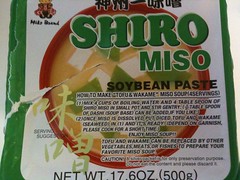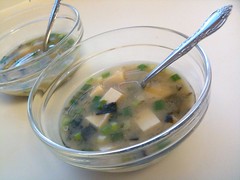I have loved Miso soup since my first taste maybe back in the late 1990s when I visited a Japanese Restaurant for the first time.
Since I have eaten Miso, I have purchased Miso soup packets at American grocery stores like Wegmans in my area. The product I purchased, in the Amazon box to the right, was so easy to make- heat water, mix the soup powder and eat! For an American like me a bit nervous to try cooking it on my own, this packet mix was perfect- and vegetarian!
Over the years, I have eaten Miso soup as an afternoon snack or a lunch item, when I wasn't so hungry. More recently, however, I have eaten the soup for breakfast a few times when I wanted something hot, flavorful and a bit "homely." Then, of course, I learned Japanese people do actually eat miso soup for breakfast! What a great, light and nutritious breakfast.
A few months ago, I began tutoring people in reading, writing and  speaking English. My first 'student', who has become a great friend is from Japan. She's been teaching me a lot about the Japanese culture: behaviors, speaking habits, interactions, and of course, cuisine! Even, for a vegetarian like me, I am learning there are many options in Japanese food. Japanese food is of course, much different than Indian. The cuisine's flavors come from different sources, yet there is an art of making Japanese food I am far from understanding!
speaking English. My first 'student', who has become a great friend is from Japan. She's been teaching me a lot about the Japanese culture: behaviors, speaking habits, interactions, and of course, cuisine! Even, for a vegetarian like me, I am learning there are many options in Japanese food. Japanese food is of course, much different than Indian. The cuisine's flavors come from different sources, yet there is an art of making Japanese food I am far from understanding!
When my friend shared the miso recipe with me (video, below), she noted it does have 'bonito' or fish flakes in it- but I could leave those out if I desired. So I did make this miso soup as in the video, again with her help finding 'konbu'. In our area (Rochester, NY) it seems Japanese Konbu, which you can see in the video is a bit long and thick, is not available. Instead, there is a Chinese konbu which is shorter and has a slightly different taste. She said I could use two to three pieces of this. I used three. Interestingly, she also told me the Chinese characters that spell konbu are very similar to the Japanese characters, so she could actually read the packet, this being true even with the English translation of 'konbu' on the packet (sea kelp, or sea cabbage).
I have to say this first attempt at making miso was fun and  tasty. I think I created a traditional taste, minus the fish, of course (so, maybe some may argue that it is traditional or authentic, maybe). I really like the layered taste, as I can taste the different flavors. I also particularly like the Japanese tofu, which is so silky, soft and seems to melt in the mouth when eating it.
tasty. I think I created a traditional taste, minus the fish, of course (so, maybe some may argue that it is traditional or authentic, maybe). I really like the layered taste, as I can taste the different flavors. I also particularly like the Japanese tofu, which is so silky, soft and seems to melt in the mouth when eating it.
What a treat! Thanks to my Japanese friend for encouraging me and helping me get the right ingredients!
Related Posts/Sites:
Ethnic Markets and other resources in Rochester, NY
Photo of Shiro Miso. An interesting note on the label on the packing.
Often the L and R sounds in American English (online ESL Lesson) are challenging for people from Japan to pronounce in a way Americans understand. Read the label on the packaging for an example of this. I am sharing this because I encourage everyone out there to be sensitive to non-English native speakers trying to learn English. It's not easy- and depending on where they come from, different sounds are easy or challenging for them to pronounce and for us to understand. Patience and slowing down is key! This advice is also coming from someone (me!) who has lived in another country (India) and also appreciated this (patience and talking slowly) to help learn Tamil when I was there!




1 comment:
Nice one , I have taste but not tried though thanks for sharing.
Post a Comment